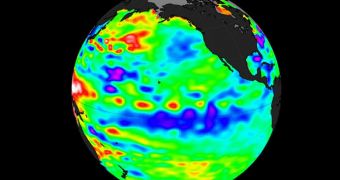Given the large number of flooding events that have taken place recently, and that are still unfolding in some ares of the world, climatologists are seeking to determine what caused such natural disasters. Their conclusion was that the intensification of La Nina was responsible for the devastation.
La Nina is an atmosphere-ocean-coupled, global phenomenon, that is the counterpart of El Nino. It is characterized by the fact that sea surface temperature across the equatorial Eastern Central Pacific Ocean are lower than normal by 3 to 5 degrees Celsius.
The pattern has global implications, as it affects the weather patterns of the entire planet, and the current circulation patterns of all oceanic currents. This causes weather disturbances all over the place.
Analysts from a variety of research groups, universities and government agencies have determined that an intensification in La Nina cues must have been responsible for the events that led to the Pakistani and Australian floods.
“This La Nina has strengthened for the past seven months, and is one of the most intense events of the past half century,” explains Bill Patzert, who is a climatologist at the NASA Jet Propulsion Laboratory (JPL), in Pasadena, California.
“The solid record of La Nina strength only goes back about 50 years and this latest event appears to be one of the strongest ones over this time period,” Patzert adds, quoted by Daily Galaxy.
“It is already impacting weather and climate all around the planet,” the expert goes on to say. The attached image, showing La Nina's current intensity, was snapped using the NASA Ocean Surface Topography Mission (OSTM)/Jason-2 satellite.
“Although exacerbated by precipitation from a tropical cyclone, rainfalls of historic proportion in eastern Queensland, Australia have led to levels of flooding usually only seen once in a century,” explains scientist David Adamec.
“The copious rainfall is a direct result of La Nina’s effect on the Pacific trade winds and has made tropical Australia particularly rainy this year,” adds the expert, who is oceanographer at the NASA Goddard Space Flight Center (GSFC), in Greenbelt, Maryland.
Climate experts explain that the reason why the ocean-atmosphere phenomenon is so powerful is because the ocean has the largest influence on the global climate of any other factors. Changes in its temperature and circulation patterns can trigger or end Ice Ages.
In an interesting twist, even the CIA and the military are preparing for the upcoming effects of climate change. Intelligence on how the situation among major power might change are scarce, as are data on how people might react, and on what the global population dynamic might look like as a result.

 14 DAY TRIAL //
14 DAY TRIAL //